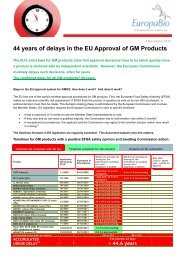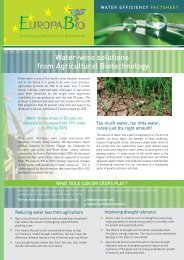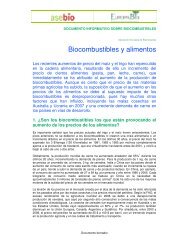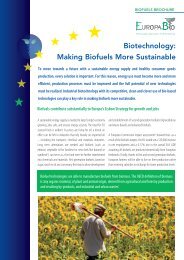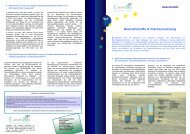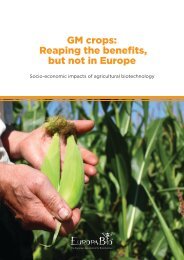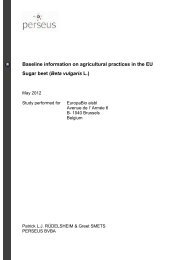Fact Sheet - Europabio
Fact Sheet - Europabio
Fact Sheet - Europabio
You also want an ePaper? Increase the reach of your titles
YUMPU automatically turns print PDFs into web optimized ePapers that Google loves.
How do these insects cause so much damage? The answer relies on two simple factors: location<br />
and number. Adult corn rootworm females lay their eggs in the soil near maize plants. A single<br />
female can lay up to 1000 eggs in her lifetime, so the number of pests present in a crop area can<br />
add up quickly and lead to extensive damage. After hatching, the young rootworms, called larvae,<br />
burrow through the ground to maize roots, where they feed. The larvae eat the fine root hairs<br />
and often burrow into roots. This removal of root tissues affects a plant’s survival by inhibiting its<br />
ability to take up water and soil nutrients. Roots also serve as an important anchoring system, and<br />
damage to them can lead to lodging and what is commonly known as a “goose neck” effect on<br />
the maize stalk.<br />
After several weeks of eating the plant from within, the larvae pupate, or form a cocoon. They<br />
emerge from the cocoon as winged adults, and can fly from one plant to the next, eating maize<br />
silks and pollen, and colonizing nearby fields. Corn rootworms do not have natural enemies in<br />
many areas where they infest maize, and once they move into a field, they can be very difficult to<br />
control. Usually a variety of different methods are needed in order to be effective. Crop rotation<br />
can help in some cases, however, WCRW and NCRW have shown to adapt to rotational control<br />
methods in the US.<br />
Differences in root mass:<br />
control (left); MIR604 maize (right)<br />
7



